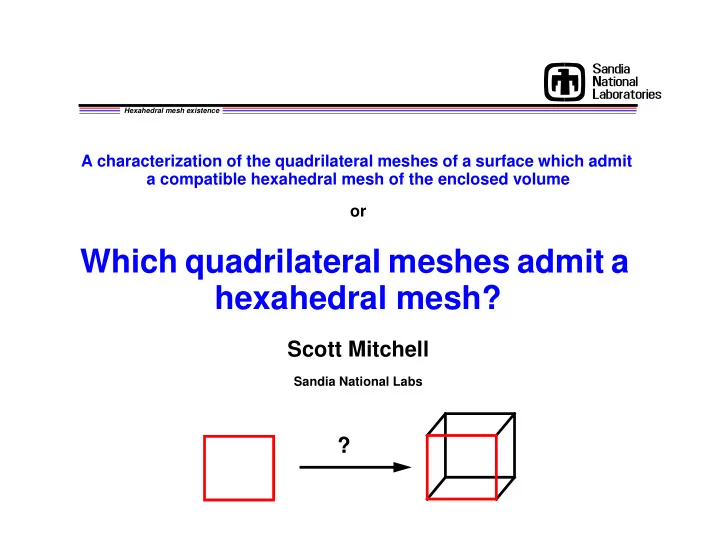

Hexahedral mesh existence A characterization of the quadrilateral meshes of a surface which admit a compatible hexahedral mesh of the enclosed volume or Which quadrilateral meshes admit a hexahedral mesh? Scott Mitchell Sandia National Labs ?
Problem Hexahedral mesh existence • start with a quadrilateral surface mesh • fill the interior of volume with hexahedra • hexes must exactly match surface mesh Folklore says hard/impossible to do. We say, can almost always be done! • ignore geometry/shape • but, pathological connectivity ruled out
Problem Hexahedral mesh existence Important industrial problem • new objects added touching meshed scene • meshing large scenes/complicated parts • meshing touching objects independently • e.g. partition domain into some mappable pieces, some not • e.g. parallel meshing of subdomains No algorithms known
Previous work Hexahedral mesh existence For triangular/tetrahedral (Bern 1993) • buffer surface mesh with one layer • mesh interior • match up (*hard part) *No dice so far for quad/hex
Proof background Hexahedral mesh existence THE WAY to think of quad/hex meshes: Spatial Twist Continuum (STC) -> higher level interpretation of duality Dual of quad mesh: • arrangement of curves, and vertices of intersection Dual of hex mesh: • arrangement of surfaces, and curves and vertices of intersection Captures difficult global connectivity constraints inherent to hexahedral meshing
2d STC Hexahedral mesh existence Triangle: Quad: dual vertices degree 3 dual vertices degree 4 no “opposite” edge. edges form 2 opposite pairs loop edge 2-cell self- intersecting chord A quadrilateral mesh and the corresponding STC.
3d STC Hexahedral mesh existence curve curve vertex surface Surface represents a layer of hexes Curve of intersection represents a line of hexes Vertex of intersection represents a single hex
Proof idea Hexahedral mesh existence Outline similar to Whisker Weaving • Map surface/mesh to a sphere (smooth) • Form STC loops - smooth closed curves • Extend loops into STC surfaces • Fix surface arrangement to avoid pathologies • Dualize back to form hexes • Inverse map back to original object ...
Necessary condition Hexahedral mesh existence Necessary: surface mesh must have even #quads Pf: Every hex mesh has an even #quads on surface: h = #hexes f = total #faces b = #surface faces 6 h = 2 f – b count faces Sufficient, too!
Initial STC Hexahedral mesh existence Def. Non-degenerate arrangement of surfaces • nowhere tangent • at most three surfaces meet at any point C 1 • surfaces regular ( continuous, parameterization) Theorem [Smale, 1957]. On a sphere: • loop with an even #self-intersections has a regular map to a circle • two loops with odd #self-intersections have a regular map between them Can use map to sweep out a surface
Maps to surfaces Hexahedral mesh existence Even #non-self intersections • two closed curves on sphere intersect even times Even #quads <=> even #self-intersections • every pair of odd loops -> one surface • every even loop -> one surface Every even quad mesh (of sphere) admits an STC
Not good enough yet! Hexahedral mesh existence STC may not dualize to a reasonable mesh, need Table 1: Hex STC A edge has two distinct nodes 2-cell in two distinct 3-cells B facet in a higher dimensional facet facet contains lower dim facet C face in two distinct hexes edge contains two distinct centroids D surface facets distinct from one another only one surface cell in an internal cell E face has four distinct edges edge contained in four distinct 2-cells F hex has six faces, ordered, etc. centroid has six edges, ordered, etc. G two nodes are in only one common edge two 3-cells share at most one 2-cell H two faces share one edge skip- fix in pillowing talk later • distinct -> STC can’t be too coarse • mostly satisfied automatically, except distinct
Fix STC Hexahedral mesh existence Idea: Not distinct? Put a sphere around it! Fix-ups may guide fix-ups in algorithms • A. 2-cell in two 3-cells • surfaces orientable, divides sphere, sides distinct • B. facet contains one lower dim. facet curve w/out surround curve with two tubes vertices
Fix STC Hexahedral mesh existence • C. edge has two distinct centroids put a ball around the non-distinct vertex
Fix STC Hexahedral mesh existence Dual must keep surface entities distinct • D. surface cell in at most one internal cell STC surface • add a ball close to surface boundary layer preserves surface surface
Fix up Hexahedral mesh existence • E. Edge in four distinct 2-cells • fix like C. put an elongated ball around the edge (caps not shown)
Extensions to non-ball Hexahedral mesh existence Idea: in a hex mesh, some edge-cycles bound a quad- rilateralized disk, hence the cycle is even Necessary condition, mesh exists only if • all cycles of edges contractible to a point in the volume are even • even #quadrilaterals meshable impossible same loops!
Extensions to non-ball Hexahedral mesh existence Idea: find a disk cutting each handle • treat as two-sided to reduce to ball case Sufficient condition, mesh exists if • for each handle, a topological disk cutting it can be found, bounded by an even cycle of edges Improvements • tighter conditions (Bill Thurston), for wild topology/surface mesh • V.A. Gasilov et al. collaboration for practical algorithm for finding disks
Conclusions Hexahedral mesh existence Surface quad mesh satisfying mild conditions admits a compatible hexahedral mesh • ball: even #quadrilaterals = necessary and sufficient • non-ball: +null-homotopic curves crossed even #times by STC loops, sufficient to find such curves Proof yields algorithm ideas Experience applying proof: small problems can have non-obvious solutions (Schneiders), unlikely to be chosen by non-STC heuristics STC slowly being used by developers (ICEM CFD, etc) V.A. Gasilov developing non-ball reduction
Recommend
More recommend